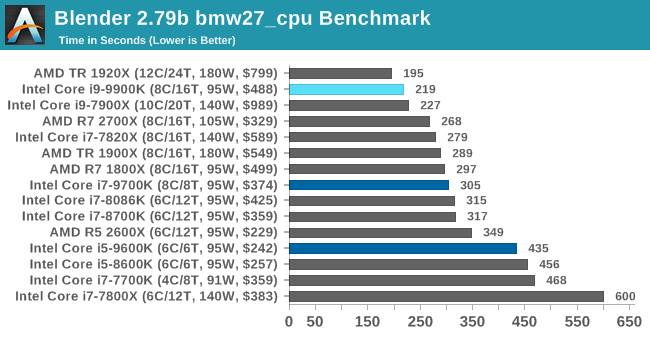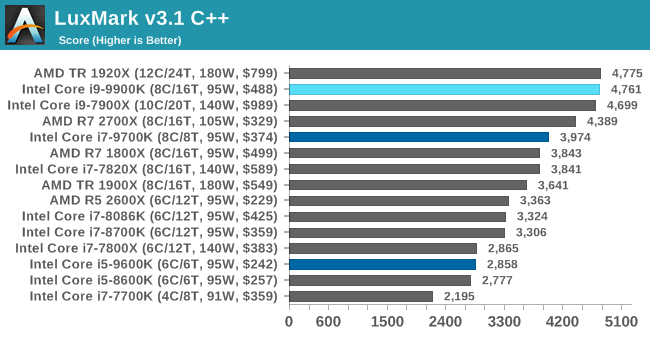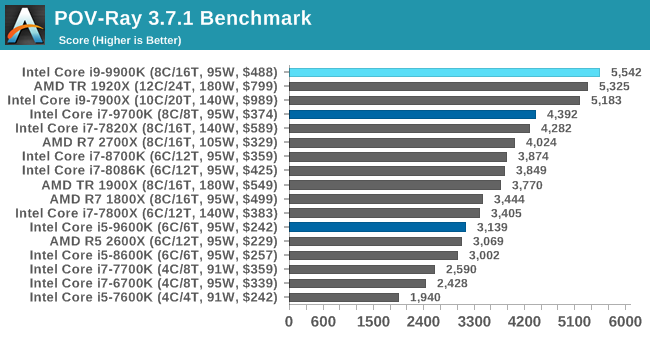The Intel 9th Gen Review: Core i9-9900K, Core i7-9700K and Core i5-9600K Tested
by Ian Cutress on October 19, 2018 9:00 AM EST- Posted in
- CPUs
- Intel
- Coffee Lake
- 14++
- Core 9th Gen
- Core-S
- i9-9900K
- i7-9700K
- i5-9600K
CPU Performance: Rendering Tests
Rendering is often a key target for processor workloads, lending itself to a professional environment. It comes in different formats as well, from 3D rendering through rasterization, such as games, or by ray tracing, and invokes the ability of the software to manage meshes, textures, collisions, aliasing, physics (in animations), and discarding unnecessary work. Most renderers offer CPU code paths, while a few use GPUs and select environments use FPGAs or dedicated ASICs. For big studios however, CPUs are still the hardware of choice.
All of our benchmark results can also be found in our benchmark engine, Bench.
Corona 1.3: Performance Render
An advanced performance based renderer for software such as 3ds Max and Cinema 4D, the Corona benchmark renders a generated scene as a standard under its 1.3 software version. Normally the GUI implementation of the benchmark shows the scene being built, and allows the user to upload the result as a ‘time to complete’.
We got in contact with the developer who gave us a command line version of the benchmark that does a direct output of results. Rather than reporting time, we report the average number of rays per second across six runs, as the performance scaling of a result per unit time is typically visually easier to understand.
The Corona benchmark website can be found at https://corona-renderer.com/benchmark

Corona is a fully multithreaded test, so the non-HT parts get a little behind here. The Core i9-9900K blasts through the AMD 8-core parts with a 25% margin, and taps on the door of the 12-core Threadripper.
Blender 2.79b: 3D Creation Suite
A high profile rendering tool, Blender is open-source allowing for massive amounts of configurability, and is used by a number of high-profile animation studios worldwide. The organization recently released a Blender benchmark package, a couple of weeks after we had narrowed our Blender test for our new suite, however their test can take over an hour. For our results, we run one of the sub-tests in that suite through the command line - a standard ‘bmw27’ scene in CPU only mode, and measure the time to complete the render.
Blender can be downloaded at https://www.blender.org/download/

Blender has an eclectic mix of requirements, from memory bandwidth to raw performance, but like Corona the processors without HT get a bit behind here. The high frequency of the 9900K pushes it above the 10C Skylake-X part, and AMD's 2700X, but behind the 1920X.
LuxMark v3.1: LuxRender via Different Code Paths
As stated at the top, there are many different ways to process rendering data: CPU, GPU, Accelerator, and others. On top of that, there are many frameworks and APIs in which to program, depending on how the software will be used. LuxMark, a benchmark developed using the LuxRender engine, offers several different scenes and APIs.

Taken from the Linux Version of LuxMark
In our test, we run the simple ‘Ball’ scene on both the C++ and OpenCL code paths, but in CPU mode. This scene starts with a rough render and slowly improves the quality over two minutes, giving a final result in what is essentially an average ‘kilorays per second’.


POV-Ray 3.7.1: Ray Tracing
The Persistence of Vision ray tracing engine is another well-known benchmarking tool, which was in a state of relative hibernation until AMD released its Zen processors, to which suddenly both Intel and AMD were submitting code to the main branch of the open source project. For our test, we use the built-in benchmark for all-cores, called from the command line.
POV-Ray can be downloaded from http://www.povray.org/












274 Comments
View All Comments
Hxx - Friday, October 19, 2018 - link
i came in here to see how my now mid range 8700k OC at 5GHZ stacks against the 9900k. It holds its own but my the 9900k is impressive. the 9700k hits 5.4ghz im hoping on a custom loop the 9900k/9700k to hit 5.5ghz without too much fuss.Alistair - Saturday, October 20, 2018 - link
You taking that on faith? Way too much heat to cross 5.2ghz.mapesdhs - Sunday, October 21, 2018 - link
5.5 without too much fuss? I guess he hasn't watched der8auer's updates on the 9900K. :Dedwpang - Friday, October 19, 2018 - link
This i9 9900k makes me remember the Prescott which is very hot and power consuming.GNUminex_l_cowsay - Friday, October 19, 2018 - link
What does "IGP" mean? If it means low enough to run on the integrated graphics then include the actual integrated graphics performance.Why are AMD cpus missing from half the gaming benchmarks. If you don't have enough time to test all the cpus then cut out the redundant components like 6700k or 7700k, or get rid of the stuff no one bought like the 8086k.
IndianaKrom - Friday, October 19, 2018 - link
Well, now we know why they soldered the chip to the heat spreader: Passing 220w through ~177 mm2 of thermal paste is an exercise in futility. Without a doubt, those all core turbo frequencies are impossible to sustain for more than a fraction of a second without either liquid metal or solder as the transfer compound. Its probably even worse than that because the power and heat isn't going to be spread evenly over the entire die, so it may be exceeding 2-3w/mm2 in places. It would be a whole different type of "Meltdown" flaw if they were still using paste with that kind of power density.mapesdhs - Sunday, October 21, 2018 - link
See:https://www.youtube.com/watch?v=r5Doo-zgyQs
nowayout99 - Friday, October 19, 2018 - link
On a scale of 1-10, I give the 9900K a 14+++++.ToTTenTranz - Friday, October 19, 2018 - link
There's some dedication to "value" in the article, yet all the graphs only show the launch MSRP for each CPU. The TR 1920X costs around $400 right now, about half of the price that appears in the graph.Also, those 2700X scores on Ashes look strange. Slower than the 2600X in a game that tends to like more cores? Something's missing..
isabirov - Friday, October 19, 2018 - link
Why power consumption of 8700k and 8086k differs so much? Shouldn't 8086k be higher than 8700k?